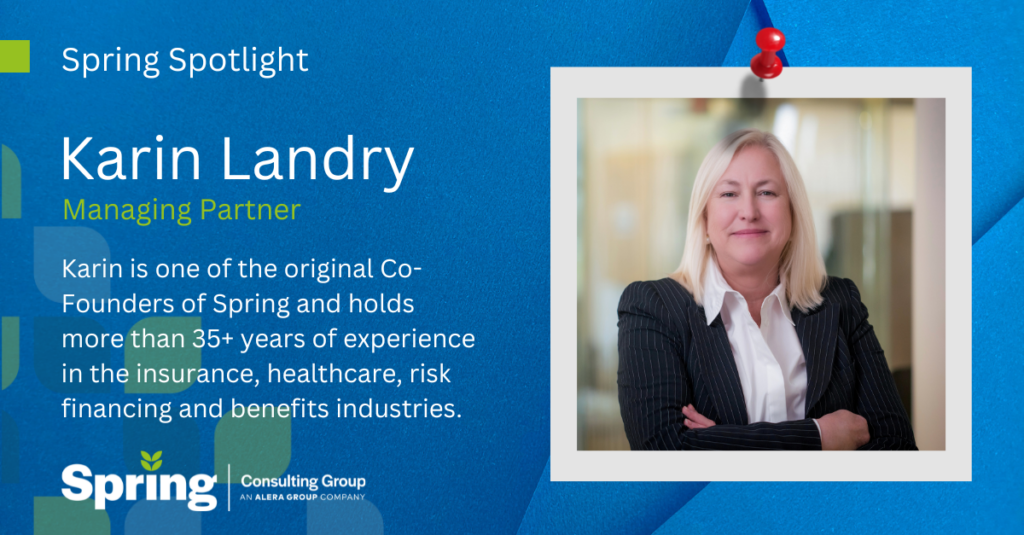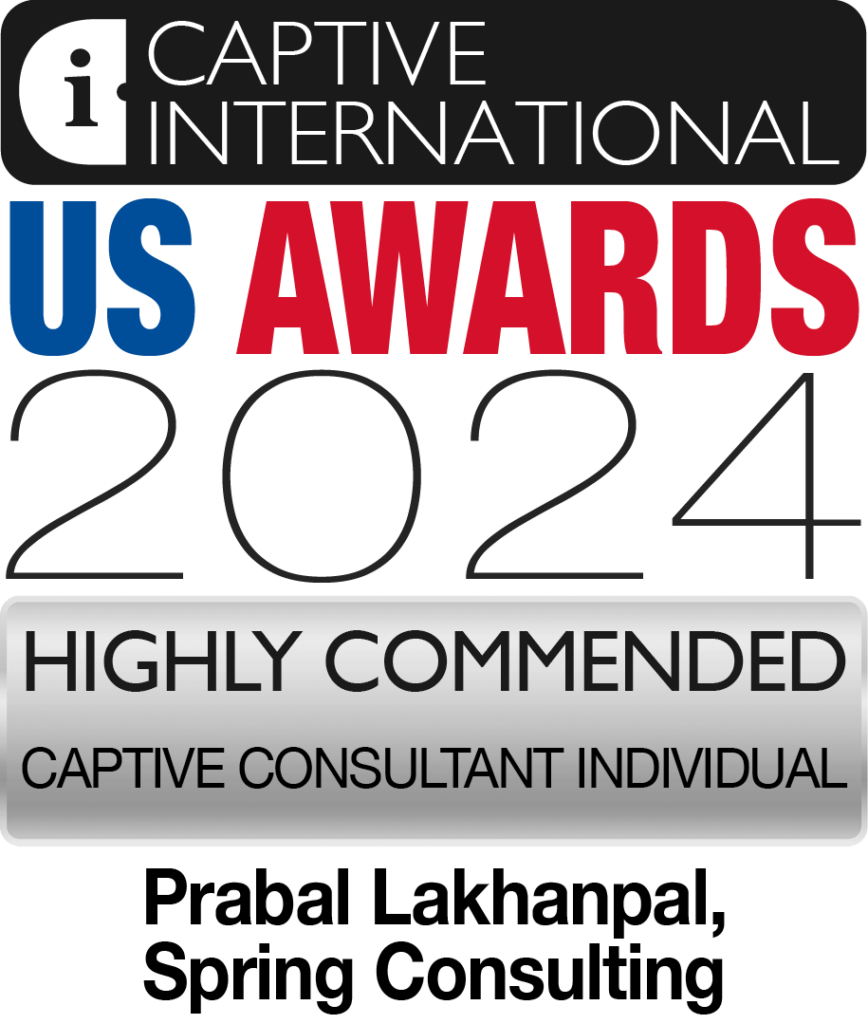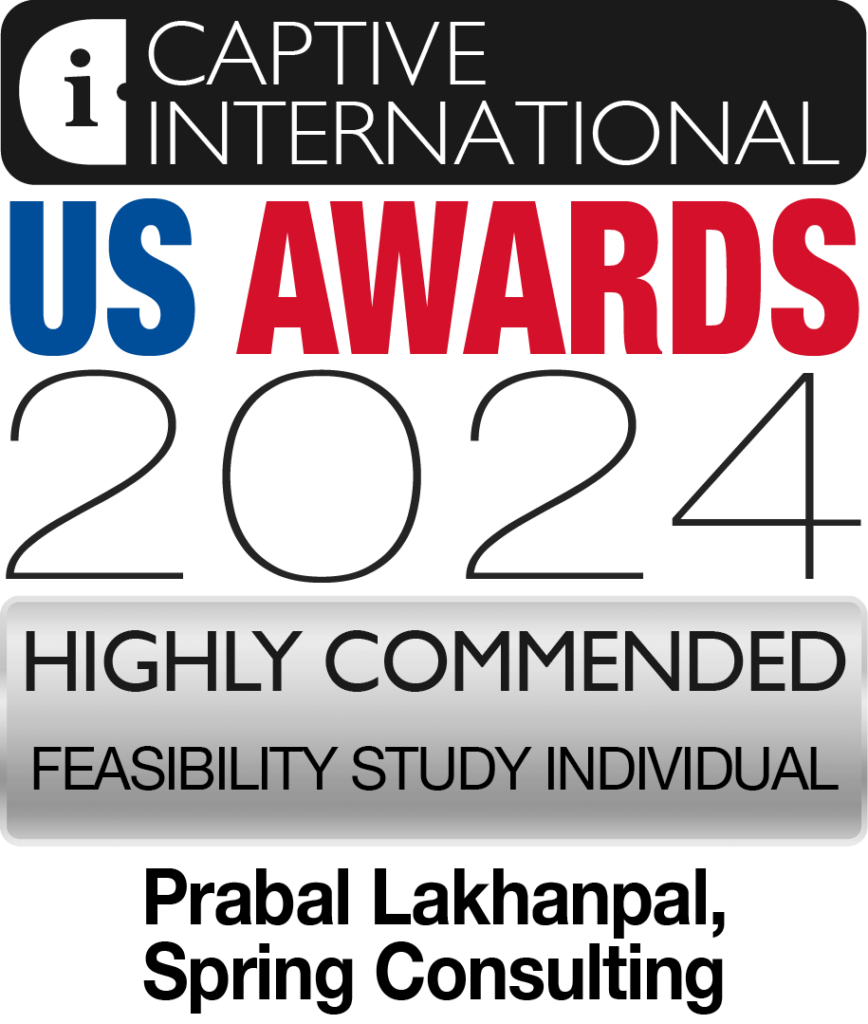Our Senior Vice President, Prabal Lakhanpal, was quoted in an article from Captive.com spotlighting how private equity firms can utilize captive insurance to lower the costs of risk. You can find the full article here.

Title:
Managing Partner
When Did You Start Spring?:
In 2004, I co-founded Spring with Karen English, Steven Keshner, John Cassell, and Teri Weber as part of a management buy-out from Watson Wyatt. I thought we could all bring unique skills that would deliver for clients.
Where Are You From?:
I’m from Burlington, MA, and I’ve lived in Massachusetts most of my life. Although now I also spend time in Rhode Island and New Hampshire.
At Work Responsibilities:
I lead the team, drive thought leadership and business development, and contribute to some of our largest consulting engagements. My role also involves shaping our firm’s strategy and fostering client relationships.
Outside Of Work Hobbies/Interests:
I enjoy traveling, playing tennis, spending time with the family and following Formula 1.
Fun Fact:
I majored in both finance and film because I was passionate about becoming a movie director. You never know where your career path will take you!
Describe Spring In A Few Words:
Awesome people doing great work!
Favorite Movie:
The Seventh Seal by Ingmar Bergman.
Pets:
2 Pets named Shadow and Tygger . Shadow is a sweet, large black labrador retriever who loves to play! Tygger is a cat (whose coloring resembles Tigger from Winnie the Pooh).
Do You Have Any Children?:
I have 2 incredible daughters: Emily (46) and Stephanie (36)
Favorite Food:
I enjoy a bit of everything, especially love variety—Thai food comes to mind first!
Favorite Place Visited:
Stockholm during the winter.
If You Were A Superhero Who Would You Be?:
Wonder Woman.
Favorite Book:
Black Bird Oracle Book by Deborah Harkness.
Name One Thing On Your Bucket List:
To visit Jerusalem.
What Is One Of Your Proudest Moments?:
Seeing my daughter graduate and get married.
If You Won The Lottery, What Is The First Thing You Would Do?:
I would donate back to the community. Rosie’s Place is a specific philanthropy I’ve been involved with and they do wonderful work on behalf of women in the Boston communities. I’d use the winnings to help those less fortunate, to help lift them up.
What Are You Passionate About?:
Delivering excellent results for clients, building long-lasting relationships, and working with the incredible team we have at Spring!
Our Vice President, TJ Scherer recently wrote an article for Captive.com outlining steps employers should consider when forming a captive. You can find the full article here.
As seen Captive International’s US Awards 2024
A conversation with Spring Consulting Group’s experts sheds light on the importance of conducting thorough feasibility studies before establishing captives.
“Key stakeholders can’t make informed decisions without a clear picture of costs and potential savings.”
Peter Johnson
A crucial step in determining whether a captive is the right fit for a company is conducting a comprehensive feasibility study. This process involves more than just a surface-level review—it’s a deep dive into the organisation’s risk profile, historical data, and financial structure to ensure the most effective and efficient use of a captive.
At Spring Consulting Group, experts such as Peter Johnson and TJ Scherer lead the charge in guiding clients through this vital evaluation. Their approach combines deep actuarial analysis, extensive industry knowledge, and an independent, unbiased perspective to help businesses uncover the full potential of captives.
In this interview, they shed light on the importance of feasibility studies, the necessary datapoints, the value of independent reviews, and how Spring’s approach sets it apart in the competitive captive consulting landscape.
Q: Why is a captive feasibility study important?
TJ Scherer: A feasibility study provides an independent assessment of the blueprint for a captive insurance company. A company needs someone to evaluate what risks should and can go into the captive and determine the appropriate retention levels. It’s about ensuring that the captive qualifies as a true insurance company, and that the insured reviews and concurs with the proposed structure.
There are various structural options such as cells, single parents, incorporated cells (both onshore and offshore) and group captives.
It’s essential to select the right captive structure and domicile that align with the company’s goals and risk profile. Without a holistic evaluation, significant factors could be missed.
Q: What kinds of datapoints are needed to conduct a feasibility study?
Peter Johnson: Initial required datapoints to kick off the review include:
- Current policy details
- Historical exposure data for each line of business
- Claims history
Metrics such as the internal rate of return and tax rates and considerations at Federal and state levels are crucial. Receiving five to 10 years of the referenced historical data helps establish the initial review and thorough process that is generally required by the commercial markets who are being proposed the captive programmes.
Key stakeholders can’t make informed decisions without a clear picture of costs and potential savings, and that’s where data becomes indispensable.
TJ Scherer: You need to consider anything that could affect the projections:
- Organisational structures
- Tax environments
- Growth potential
- Acquisitions
Without comprehensive information, recommendations might not reflect the true state of the company and proposed captive structure. Open communication is key to ensuring our analysis reflects both current and future realities.
Q: What is the value of an independent viewpoint?
TJ Scherer: Independence allows an unbiased review of the current and proposed programme. Sometimes, the players involved are too invested in the status quo, which means options such as captives aren’t fully explored. By engaging an independent consultant, you’re ensuring that someone is evaluating the programme without an agenda, is focused solely on the insured and is agnostic to the domicile or ultimate structure of the proposed programme.
Peter Johnson: Having an independent review with a captive consulting focus can shed new light on value-adding options for the insured.
“The key is to start early enough to implement changes before issues become larger concerns.”
TJ Scherer
Q: How does loss experience come into play?
Peter Johnson: Loss experience is a vital factor, especially when determining whether a captive is a viable solution and to determine appropriate captive premium level. For example, if your loss ratio is consistently low—around 50 percent or below—it may indicate inefficiencies in the commercial market, allowing a captive to become a more cost-efficient risk funding solution.
When it comes to developing captive premiums, we analyse historical loss experience along with exposure and captive retention levels to determine the projected funding for the captive, ensuring there’s enough premium to cover expected losses and operating costs in expected and adverse scenarios.
TJ Scherer: It’s important to consider the frequency versus severity of losses. A high loss ratio could be due to one large claim over 10 years, but commercial markets may still hold that against the insured on renewal. Understanding these nuances is fundamental in designing the right retention and funding levels.
Q: What key insights can be uncovered from a captive feasibility study that inform a captive strategy?
TJ Scherer: A feasibility study can open options the insured may not have considered. For example, an insured might think its premiums are too high, but upon evaluation, they could find that their premium is actually reasonable, but there are possible savings by changing the current retention.
These studies broaden the insurance programme’s view, exploring the total cost of risk and the potential savings and loss scenarios, all focused on helping make go/no-go decisions on the captive strategy.
Peter Johnson: The study provides a transparent view of what the next few years could look like from a financial standpoint. It highlights costs such as upfront capitalisation and ongoing premiums which provide decision-makers with the information they need to make informed choices. It can address the best course of action around what exposures to add to the insured’s captive, and when.
Q: What makes Spring’s captive feasibility study process unique?
Peter Johnson: At Spring, we have internal credentialled actuaries that span both benefits and property and casualty (P&C), which is rare in the industry. Our actuarial expertise and integration of our consulting expertise across multiple disciplines allows us to deliver powerful, independent feasibility studies.
Everything is typically handled in-house and heavily peer-reviewed, ensuring that each study is viewed through various lenses to push the analysis further.
TJ Scherer: Our review process involves blind evaluations, where someone unfamiliar with the project assesses the study, ensuring it aligns with the insured’s goals and objectives. This internal scrutiny helps us address the full scope and deliver a comprehensive solution.
Q: Do you ever conduct ‘refeasibility’ studies, and if so, what is their value?
Peter Johnson: Yes, refeasibility studies are valuable, especially for existing captives. We recently worked with a large energy company to revisit its entire programme. By reassessing the insured’s current coverages, retentions, and domicile, we confirm the current structure is maximising efficiency or propose possible areas of change. It’s a process we recommend every three to five years to ensure the programme remains optimised.
TJ Scherer: Captives need to adjust to the market and their insureds’ needs, so refeasibility studies or annual actuarial updates are essential. Without periodic reviews, captives may lose their value or fail to meet the insured’s goals over time.
Q: When is the right time to start a captive feasibility study?
TJ Scherer: There’s no wrong time, but the sooner, the better. Some clients like to initiate a feasibility study right after renewal, while others may prefer mid-term evaluations. The key is to start early enough to implement changes before issues become larger concerns.
Each insured operates on a different timeline, but a typical feasibility study takes four to eight weeks from the start. From there, if a decision to form is made, it can take another two months or more to get to formation, depending on internal approvals and other timelines.
Captive International has released the winners for the 2024 US Awards. Spring is proud to announce that our team has been recognized among the best in the industry for Top Feasibility Study (Firm), Top Feasibility Study (Individual) and Top Captive Consultant (Individual). You can access the full list of winners here.



On September 1, 2024, we celebrated a significant milestone: the 50th anniversary of the Employee Retirement Income Security Act (ERISA). Signed into law by President Gerald Ford on September 2, 1974, ERISA has quietly yet profoundly impacted the lives of countless Americans, ensuring that promises made regarding retirement and health care benefits are promises kept.
ERISA: A Commonly Overlooked Law That Impacts You
While the average American may not recognize the name, ERISA likely plays a crucial role in their lives. This landmark legislation sets minimum standards for most established retirement and health plans in the private sector, providing essential protections for plan participants and beneficiaries in employee benefits plans. From safeguarding retirement savings to ensuring that benefits regulations and requirements are adhered to, ERISA has been a cornerstone in the benefits industry for the past five decades.
A Journey Through ERISA’s History¹
The story of ERISA began with a series of broken pension promises that left thousands of employees without the benefits they were owed. The most notable case was the closure of Studebaker’s South Bend, Indiana plant in 1963, where workers were denied the pensions they were promised. This incident, among others, underscored the urgent need for pension reform and captured the public’s attention.
In response, President John F. Kennedy created the President’s Committee on Corporate Pension Plans in 1961, which issued its report in 1962. Senator Jacob Javits introduced pension reform legislation in 1967, and the momentum continued to build, especially following the release of the 1972 Peabody Award-winning documentary, Pensions: The Broken Promise. Public hearings were held, legislative efforts advanced, and finally, the Employee Retirement Income Security Act was signed into law in September 1974.
Senator Javits, the principal sponsor of ERISA, described it as “the greatest development in the life of the American worker since Social Security.” ERISA has shaped how employers provide retirement and health benefits, working behind the scenes to set standards that protect millions of workers and their families. ERISA was passed by the House in a vote 407 – 2 and unanimously approved in the Senate demonstrating how united the country was behind this important piece of legislation.
The Evolution of Employee Benefits and Captives
ERISA’s influence extends beyond traditional employee benefits. Over the years, there has been notable growth in employee benefits provided through captives—specialized insurance companies owned by the businesses they insure. This trend has enabled companies to have greater control and flexibility over their benefits offerings while managing risks more efficiently. Not all benefits are subject to ERISA, as seen below, but if they are, they need to go through a filing process with the Department of Labor (DOL) to receive a prohibited transaction exemption (PTE). The goal of the PTE process is to ensure that the interests of plan participants in the captive model are still protected, through an additional layer of DOL oversight surrounding fair pricing and compliance.
As captives grow in popularity, they provide new opportunities for employers to offer competitive, tailored benefits while achieving cost control—a trend ERISA has helped enable by providing the regulatory framework necessary for captive expansion and innovation.
Looking to the Future: ERISA’s Continued Relevance
Fifty years on, ERISA remains as relevant as ever. A recent example of ERISA’s modern influence is the tentative approval given by the DOL to leverage a captive to fund pension plan risk for the first time. This development benefits both plan sponsors (employers) grappling with pension plan liability and benefits recipients.
As we navigate new challenges in the benefits landscape—from evolving retirement needs to the complexities of modern healthcare—ERISA provides a foundation that ensures the rights and protections of millions of Americans are upheld.
1 https://www.dol.gov/agencies/ebsa/about-ebsa/about-us/history-of-ebsa-and-erisa
As Vermont was named the largest captive domicile globally in 2022, it has developed into a hub for alternative risk financing and insurance innovations. The Vermont Captive Insurance Association (VCIA) recently hosted its 2024 Annual Conference, a beacon in the captive insurance industry. This year’s conference, held in the heart of Vermont (Burlington), offered a dynamic platform for industry professionals to delve into the evolving landscape of captive insurance. From exploring the fundamentals of captive formation to addressing the pressing challenges posed by emerging technologies and regulatory changes, the conference provided invaluable insights and strategies. Attendees had the opportunity to engage with thought leaders, share best practices, and discover innovative solutions that will shape the future of the industry.

1) Captive Formation and Feasibility
Since Vermont is the most popular domicile globally, VCIA provides a great avenue to help first-time employers explore potential captive endeavors. Understanding the basics of captive formation and testing for feasibility is essential for anyone looking to establish or manage a captive insurance company. Here are some related sessions that caught my eye:
-The opening session, “Captive Immersion: Feeling Puzzled? Let’s Piece It Together,” brought together various stakeholders, including an attorney, underwriter, actuary, consultant and a state official to give piece-by-piece instructions on entering the captive industry.
– The presentation, “The Economic Landscape & Your Captive’s Investment Portfolio,” reviewed the current state of the economy and macroeconomic factors that may influence investment gains in a captive.
2) Emerging Technologies and Innovation
As the risk landscape evolves rapidly, captives must adapt to emerging tools and technologies. Addressing emerging risks such as cyber threats and leveraging innovations like AI and data analytics are vital for maintaining relevance and effectiveness in risk management, ensuring captives can proactively manage and mitigate modern challenges. These presentations spotlighted the need for alternative solutions to address emerging (and at times unforeseen) risks:
– The Cost of Compliance: ADA/FMLA Court Cases and Jury Verdicts offered a deep dive into recent legal cases, providing lessons on how to avoid costly compliance mistakes.
– The presentation, “Your Data Reimagined! A Captive Case for Data Visualization,” showcased how employers can utilize data visualization to help interpret large data sets and areas for risk optimization.
3) Regulatory and Compliance Updates
Navigating the complex regulatory environment and staying updated on captive taxation and oversight changes are crucial for compliance and strategic planning. It is essential that captive managers and owners are informed about regulatory requirements and can adapt their practices to remain in good standing and avoid potential legal pitfalls. Some insightful sessions include:
– Our VP, TJ Scherer, teamed up with the State of VT’s Dan Patterson in an open discussion group to chat about “Upcoming Changes in Regulation Oversight” and what captive owners in VT should keep their eyes out for.
– Four tax experts convened to discuss “Captive Taxation: What’s New & What’s Next.” They reviewed recent IRS, federal and state updates and discussed how companies can best prepare for an IRS audit.
4) Passing the Torch
Energizing new leaders and providing growth opportunities for newcomers are essential for the long-term sustainability of the captive insurance industry. By fostering new leadership, organizations can drive future success and address the ongoing challenge of talent shortages. These topics focused on the importance of developing talent to ensure that fresh perspectives and innovative ideas are woven into the industry:
– State of VT’s Chief Examiner, Heidi Rabtoy’s “Discussion Group: Attracting & Energizing New Leaders” spotlighted the current talent shortage in the insurance space, and tips to attract and retain next-generation industry leaders.
– One of my favorite parts of VCIA is the Newcomers’ Orientation; ensuring first-time attendees are educated and feel welcome is essential to the industry’s future success.
The enthusiasm and forward-thinking discussions from this year’s conference left a lasting impact on the captive insurance landscape. The conference highlighted the importance of understanding the fundamentals of captive formation and staying ahead of emerging risks, underscoring the critical need for compliance amidst shifting regulations. Moreover, the focus on cultivating new leadership promises a vibrant future for the industry. By harnessing the knowledge and connections gained at VCIA, risk professionals are well-equipped to navigate the complexities ahead and drive continued success in the world of captive insurance.
In a recent podcast from the International Risk Management Institute (IRMI), or Chief P&C Actuary, Peter Johnson gives an inside view into the actuarial methodologies that go into calculating loss development patterns and optimizing risk management strategies across long-tail lines. You can find the full podcast episode here.
Spring has won Captive Review’s US Awards the top Captive Consultant of the Year. You can find the full list here.

